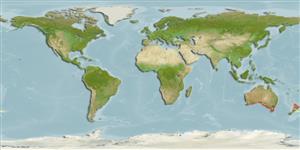Klassifizierung / Names
Namen | Synonyme | Catalog of Fishes(Gattung, Arten) | ITIS | CoL | WoRMS | Cloffa
Environment: milieu / climate zone / depth range / distribution range
Ökologie
seewasser demersal; tiefenbereich 10 - 400 m (Ref. 26613), usually ? - 200 m (Ref. 26613). Subtropical; 30°S - 44°S, 134°E - 154°E
Southwest Pacific: known only from Coffs Harbor in northern New South Wales to Portland in Victoria, including Bass Strait and Tasmania.
Length at first maturity / Size / Gewicht / Alter
Maturity: Lm ?, range 36 - ? cm
Max length : 65.0 cm TL Männchen/unbestimmt; (Ref. 6390); max. veröff. Gewicht: 3.0 kg (Ref. 6390); max. veröff. Alter: 12 Jahre (Ref. 27203)
Found in inshore waters over the continental shelf. Sometimes entering coastal bays (Ref. 9563). Tiger flathead are not active fish and will normally rest on the sea bed during the day in areas of mud and sand substrate (Ref. 6390). They may migrate into the water column at night following prey species (Ref. 27197). Adults feed mainly on small fish such as silversides and three-spined cardinal fish (Ref. 27193) while juveniles feed primarily on crustaceans including krill. The young inhabit shallow waters of the continental shelf and move into the outer shelf zone as they reach maturity (Ref. 6390). Its fin spines are venomous and can inflict mild to severe pain (Ref. 125684).
Paxton, J.R., D.F. Hoese, G.R. Allen and J.E. Hanley, 1989. Pisces. Petromyzontidae to Carangidae. Zoological Catalogue of Australia, Vol. 7. Australian Government Publishing Service, Canberra, 665 p. (Ref. 7300)
IUCN Rote Liste Status (Ref. 130435)
Nutzung durch Menschen
Fischereien: kommerziell; Sportfisch: ja
Mehr Information
ReferenzenAquakulturAquakultur ProfilZuchtlinienGenetikElectrophoresesVererbbarkeitKrankheitenVerarbeitungNutrientsMass conversion
PartnerBilderStamps, Coins Misc.LauteCiguateraGeschwindigkeitSchwimmstilKiemenoberflächeOtolithsGehirngrößeSehfähigkeit
Tools
Zusatzinformationen
Download XML
Internet Quellen
Estimates based on models
Preferred temperature (Ref.
123201): 12.6 - 18.2, mean 14.9 °C (based on 139 cells).
Phylogenetic diversity index (Ref.
82804): PD
50 = 0.5000 [Uniqueness, from 0.5 = low to 2.0 = high].
Bayesian length-weight: a=0.00525 (0.00246 - 0.01120), b=3.04 (2.85 - 3.23), in cm total length, based on LWR estimates for this (Sub)family-body shape (Ref.
93245).
Trophic level (Ref.
69278): 3.9 ±0.62 se; based on food items.
Widerstandsfähigkeit (Ref.
120179): mittel, Verdopplung der Population dauert 1,4 - 4,4 Jahre. (K=0.17-0.38; tm=4-5; tmax=12, Fec=1.5 million).
Fishing Vulnerability (Ref.
59153): Moderate vulnerability (39 of 100).
Nutrients (Ref.
124155): Calcium = 135 [13, 597] mg/100g; Iron = 2.32 [0.62, 5.87] mg/100g; Protein = 17.7 [15.4, 20.0] %; Omega3 = 0.362 [0.169, 1.010] g/100g; Selenium = 77.5 [21.3, 272.2] μg/100g; VitaminA = 12.8 [4.3, 36.7] μg/100g; Zinc = 0.698 [0.317, 1.417] mg/100g (wet weight);
